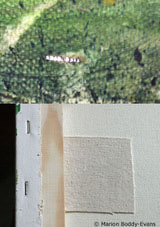How to Repair a Damaged Canvas
You’ve finally finished your masterpiece. After hours and days laboring on your painting, carefully putting your inspiration on canvas, you’re excited to display it. Unfortunately, you or someone else accidentally ripped a small area on your painting. What do you do?
Don’t panic. There are two ways to repair a torn, ripped, punctured, or damaged canvas: patching or lining. Before fixing your canvas, you have to consider some factors that would affect the end result of your repair. If the damage is small, patching would be a good remedy. Patching is a quick and easy solution to tiny punctures, L-shaped tears, and small tears. For damages affecting a large area or if the small tears are located in several areas, lining is the best way to fix the canvas. For old oil paintings, professional art restorers prefer to do lining since most aged canvas are brittle, fragile, and more susceptible to damage when not reinforced.
Patching
Here are the steps for patching a canvas:
1. Smooth out the area where the tear is located. Clean up any fibers that may have unraveled.
2. Cut a piece of canvas with at least an inch wider than the tear. If you have a lighter weight canvas than the one you’re repairing is best to use.
3. Glue the patch at the back of the tear. Use acrylic-gesso or an acid-free glue in patching. Apply a thin layer of glue to the patch. If you use too much glue, it will only squeeze out of the patch and get on the front of the canvas which will leave an unnecessary stain.
4. While the glue is still wet, check the tear at the front of the canvas. Use a pair of tweezers to put back loose threads in place. Carefully arrange the threads to fill the damage.
5. Inpaint the patched area, if needed. If it’s your own work, it would be easier to repaint the repaired area.
Tips:
- Work with patience and care.
- Hire a professional art conservator or restorer for fixing valuable and antique paintings. They can do a more refined repair of an old painting.
- Patching done in a busy area of the painting is less noticeable than a patch in a solid area.
- Just because the patch is located behind the canvas, doesn’t mean you will do a sloppy repair. Make the patch neat and professional-looking so if someone sees the repair, they won’t be dismayed with the whole painting.
Image source: http://painting.about.com
